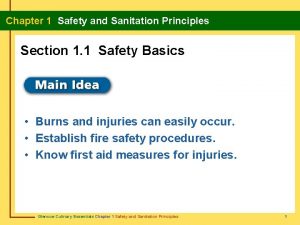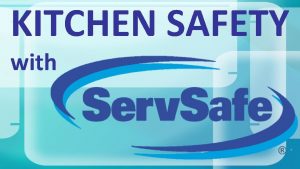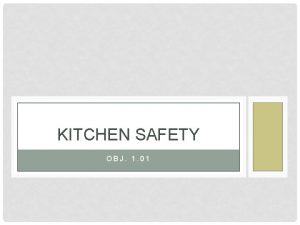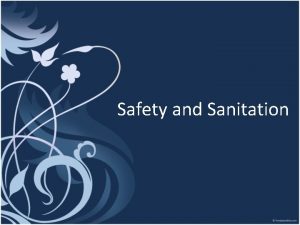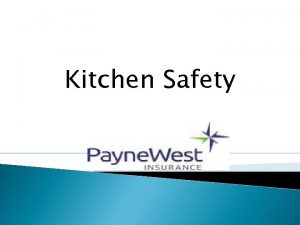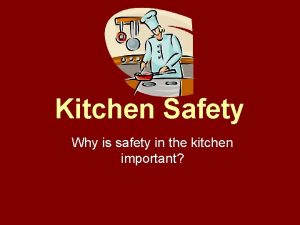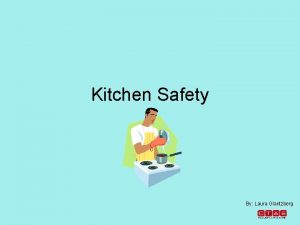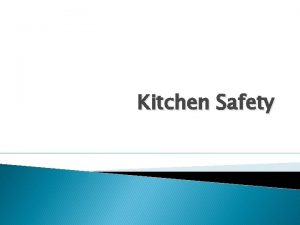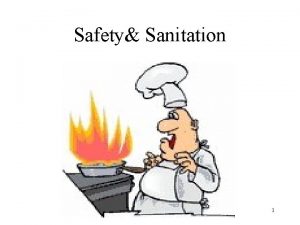SAFETY AND SANITATION SANITATION IN THE KITCHEN Every









- Slides: 9

SAFETY AND SANITATION

SANITATION IN THE KITCHEN • Every second of every day someone in the US becomes stricken with a foodborne illness- food poison caused by eating spoiled or food containing harmful bacteria- one celled organisms can only be seen with microscope • Bacteria double in number ever 20 to 30 minutes under certain conditions • Make sure utensils are washed properly to prevent crosscontamination- harmful bacteria transferred from one food to another • 85 % of all food borne illnesses are avoidable • Take time to sanitize- clean to get rid of bacteria

SANITATION IN THE KITCHEN • • • • Wash hands with warm, soapy water before handling food Wash hands after handling raw meat, poultry, fish, or using the bathroom Wear clean clothes Use separate towels for drying hands and dishes Use clean sponges for cleaning Keep all surfaces clean Wash raw fruits and veggies under cold water Thaw frozen foods in the refrigerator or microwave Wash cutting boards after cutting raw meats, poultry, or seafood Sanitize cutting boards with 2 tsp. of bleach and 1 qt of water for at least 30 seconds Thoroughly wash all utensils you use to prepare food to avoid cross contamination Use a clean spoon every time you taste food during cooking Cook meats thoroughly to kill harmful bacteria Keep hot food hot and cold food cold Refrigerate or freeze leftovers within two hours of serving

WORKING SAFELY IN THE KITCHEN • More accidents take place in the kitchen than any other room in the home • Prevent accidents by thinking ahead and working safely

PREVENTING CUTS AND BRUISES • • • Wash knives and other sharp objects separately Never put a sharp knife in the sink of sudsy water Store sharp knives separately from other utensils Use a cutting board Keep knives sharp to avoid slipping while cutting Unplug garbage disposal before getting an object out of it Close cabinet doors and drawers when not in use Use ladder or step stool to reach hard items Wipe up spills right away

PREVENTING BURNS • Don’t touch heating units on a range • Use flat bottom cookware and well balanced cooking utensils on the range so they wont tip • Turn handles inward, so not knocked off • Make sure they do not extend over another heating unit • Use thick, dry potholders when handling hot cookware • Remove a pan cover by lifting far side cover first • Dry food thoroughly before placing into pan of hot oil (water causes it to splatter) • Use tongs to remove food from hot water and turn frying foods

PREVENTING FIRES • Grease fires- NO WATER! Use pan cover, salt, or baking soda • Keep fire extinguisher in kitchen • Avoid wearing dangling jewelry or loose fitting clothes • Keep towels and electrical cords away from range • Don’t use the oven as a heat source to warm kitchen • Avoid using a dish towel to handle hot cookware • Avoid overloading circuits- no more than 2 into an outlet at a time

PREVENTING ELECTRICAL SHOCK • • • Should be in good working condition and used properly Water and metal are powerful conductors of electricity Use dry hands when touching electrical equipment Never plug in an appliance while standing on a wet surface Don’t put an electrical appliance in water unless immersible Always unplug a cord from the wall before removing it from the appliance • Disconnect appliances by pulling on plug not cord • Keep forks/knives out of electrical toasters

PREVENTING POISONING • Many household chemicals contain substances that can be poisonous if swallowed, inhaled, or splashed on skin • Keep the poison control number by the phone • Read all labels and warnings • Follow directions • Keep chemicals in original containers • Store out of the reach of children and away from food • Don’t mix chemicals together
 Chapter 1 safety and sanitation principles
Chapter 1 safety and sanitation principles Prepositions of place kitchen
Prepositions of place kitchen In the kitchen or at the kitchen grammar
In the kitchen or at the kitchen grammar Every nation and every country
Every nation and every country Microsoft mission and vision
Microsoft mission and vision Every nation and every country
Every nation and every country Every picture has a story and every story has a moment
Every picture has a story and every story has a moment Every knee shall bow every tongue confess
Every knee shall bow every tongue confess Every rotarian every year
Every rotarian every year Every child every day
Every child every day
